Recent Water Damage Posts
Insulation can work as an absorbent sponge after water intrusion.
8/24/2022 (Permalink)
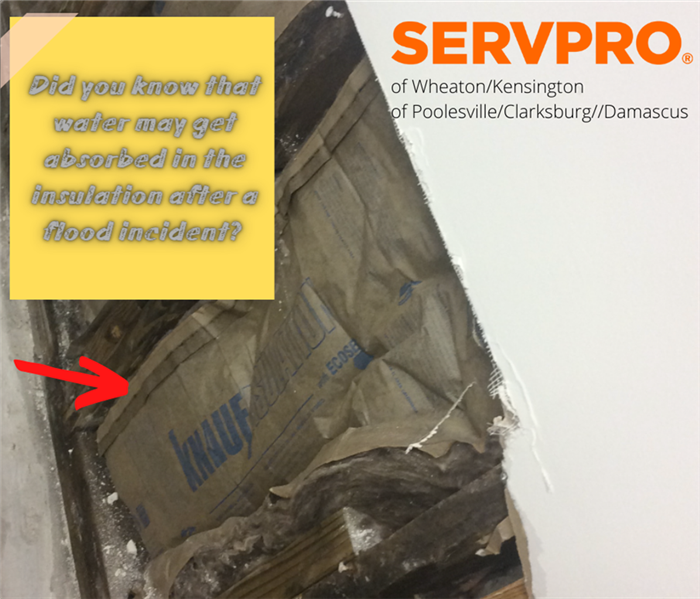 We can help!
We can help!
After a flood in a finished area of your home, do you ever wonder where the water went after hours of the flood incident? In many cases, the water ends up soaked inside the insulation behind the walls. This happens because the insulation works as an absorbent sponge, if it sits there long enough, it can cause microbial growth. So remember, if the affected area appears to be dry because the water is gone, the water has gone somewhere else. Feel free to reach out if you experience water damage and want to get an idea of the true extent of the damage, and understand what needs to be done to properly mitigate the water damage. Always remember that your local SERVPRO of Wheaton/Kensington is always here to help!
Can wooden floors be restored after buckling?
8/8/2022 (Permalink)
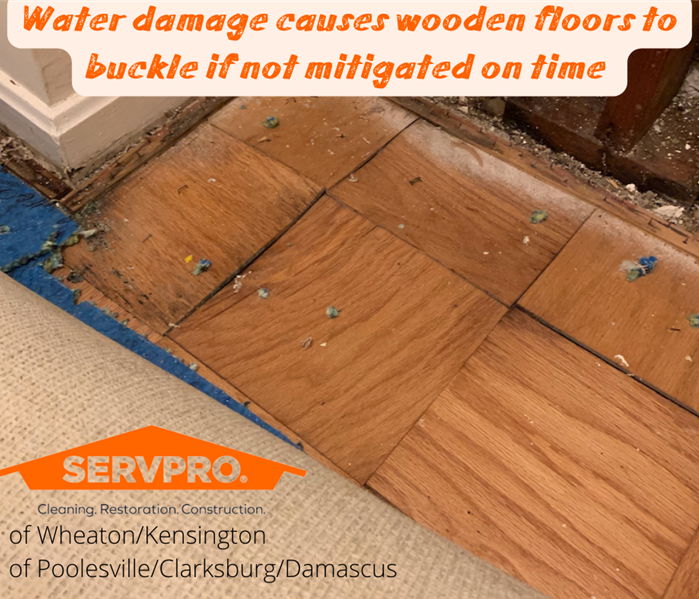 Call experienced professionals to assist with water damage!
Call experienced professionals to assist with water damage!
Water damage can cause permanent damage if not mitigated properly and on time. Buckled floors are a good example of why prompt mitigation makes the difference between having to restore or replace. The reason behind wooden floors buckling after coming in contact with moisture or water is that wood expands gradually after contact with water or moisture for an extended period of time. Once wooden floors have buckled they are deemed non-salvageable and have to subsequently be replaced.
Another factor that deems post-flooded wooden floors non-salvageable is the category of water damage, if the water is considered contaminated or a category 3 water loss, it has to be replaced. Unfortunately, in that scenario, the floors cannot be returned to their prior flood conditions.
If you are experiencing any type of water damage or water intrusion give us a call, our team is experienced and capable of restoring and making it “Like it never even happened!”
Water mitigation services from SERVPRO of Wheaton/Kensington
2/10/2022 (Permalink)
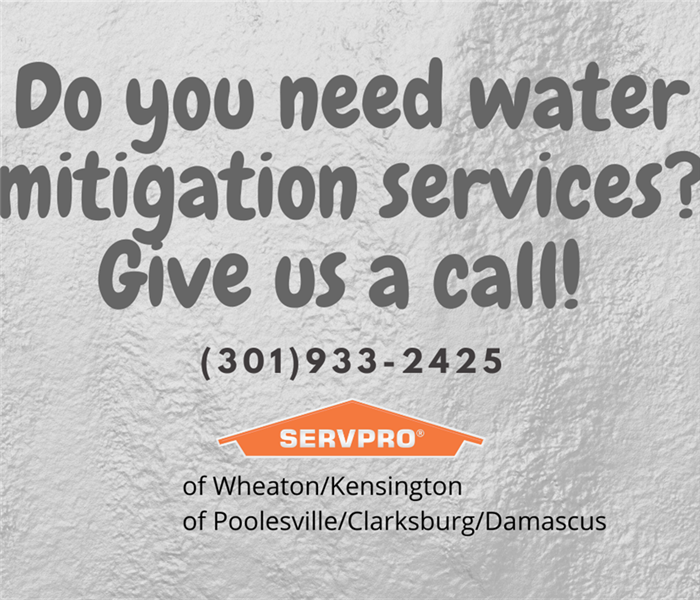 We are always here to help!
We are always here to help!
Water damage restoration services are one of the most common mitigation work calls that we get on a regular basis. In most cases, the homeowner or business owner did not expect it and is not prepared. This causes the client to feel helpless and distraught. We would like to share a few tips on how to react if this happens in your place of work or home.
- Broken water pipe- Turn off the main water shut-off valve, this will prevent further damage. If you do not know where it is, find it and label it for preparedness.
- Water intrusion from storm- If you can, unclog your outdoor drain so that water can have an exit route away from your home. This type of water is considered contaminated, you should not attempt to mitigate it yourself.
- Slow leak- If you discover a slow leak, have a plumber repair the broken pipe. Soon after the repair, call us to begin the water mitigation process to prevent mold/microbial growth.
- Appliance failure- If an appliance malfunctions, like a broken water line from the refrigerator or a dishwasher leak, we recommend that you shut off the water and begin water mitigation soon after. To prevent this, have your appliances and their water lines inspected from time to time.
Water damage is not a fun topic, we know, but it does happen! Be prepared. Reach out to your insurance provider and learn more about your water damage coverage. Have our contact information handy, just in case a disaster like this strikes your home or business. We are always here to help and make it “Like it never even happened.”
Caution, Frozen pipe weather ahead!
1/12/2022 (Permalink)
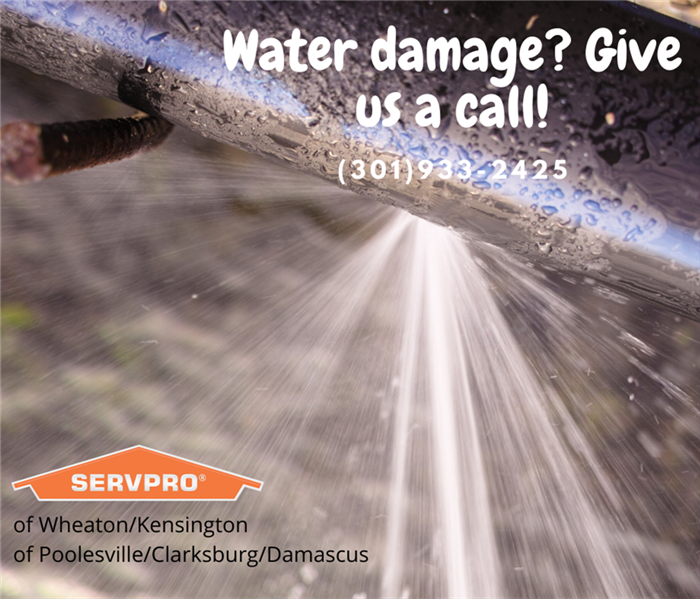 We are always here to help with your water restoration needs!
We are always here to help with your water restoration needs!
Happy winter of 2022, DMV! The weather in our area can be unpredictable sometimes and this winter season is no exception. We have already received our first snow storm of the season and next week we will receive the next. Along with snow, we are expecting low temperatures in the coming days. This is a recipe for broken pipes and potential water damage. Here are a few tips to know just in case you experience water damage due to a broken water pipe.
- Know where your main water shut-off valve is and shut it off if you have a leak
- Open your faucets so that thawing water can freely drain and relieve the pressure
- Use either a small space heater or a hair dryer to warm up the frozen pipe
- Give our team a call for water mitigation services
Water damage from a broken pipe is considered a category 3 water loss, per the IICRC. Our intention is to restore rather than replace, which is why we recommend that you access the water damage right away. Waiting for the water to dry on its own is not a proper way to mitigate water damage, this actually increases your chances for mold. If the water damage restoration cost is higher than your homeowners insurance deductible, we may recommend that you reach out to your insurance company to place a claim.
For expert advice on how to proceed after you experience water damage, give us a call, we are always here to help!
Why do wooden floors buckle?
11/3/2021 (Permalink)
 Save your wooden floor by restoring water damage promptly!
Save your wooden floor by restoring water damage promptly!
Ever wonder why wooden floors buckle? The short answer to that question is- they buckle due to moisture. Moisture makes wooden textures expand. The question that requires more thought process is- where is the moisture coming from? Here are a few examples of what may be the cause of your buckled wooden floor.
- Slow leakage- In some cases, there may be a slow leak that has gone unnoticed and caused damage to its surrounding areas, including wooden floors. Once your floor has buckled it usually has to be replaced due to the wooden floor boards being expanded beyond repair.
- Seasonal Moisture- During more humid seasons like spring, it is a good idea to set up dehumidifiers in areas of your home or business that are more susceptible to collect humidity. Though it would take quite a bit of time for this to cause your wooden boards to buckle up, this is still a possibility.
- Water damage- Water damage is the most common reason that we see all the time that causes permanent damage to your wooden floors. The quicker you assess the water damage, the more likely you are to salvage them from buckling up.
We recommend that you follow your floor manufacturer guidelines when maintaining and treating your wooden floors in order to prevent damaging them. We hope that you have found this information helpful. If you come across any of these issues, please reach out for further assistance. Our team is available 24/7/365 to help and restore.
Oh no, a sewage back-up? SERVPRO of Wheaton/Kensington can handle it!
5/24/2021 (Permalink)
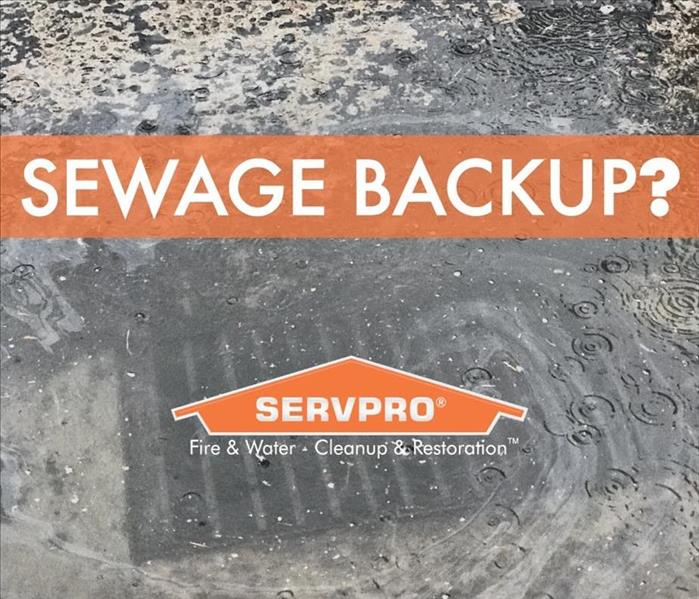 SERVPRO of Wheaton/Kensington is capable of making it "Like it never even happened."
SERVPRO of Wheaton/Kensington is capable of making it "Like it never even happened."
What do you do when you experience a sewage backup disaster? Well, first things first, have your plumber access the backed-up pipeline for repairs. Once the pipe is repaired, call SERVPRO, the #1 professionals in the restoration industry. When dealing with a sewage backup it is important to know and understand that this is what we in the restoration industry consider a category 3 water loss. What does that mean? We are happy that you asked! A category 3 water loss is water that is considered “grossly contaminated” and contains harmful toxins or pathogens. Or in other words, you do not want to come in close to this type of water because it can be harmful to your health. In fact, in this case our team removes all non-porous material such as drywall, insulation, baseboards, etc. in order to remove all contamination. Once we have restored the affected areas, our team has the capacity to perform the reconstruction portion also. If you are experiencing a sewage backup give our office a call, we will be happy to help and make it “Like it never even happened.” Remember that your SERVPRO of Wheaton/Kensington is is available 24 hours a day, 7 days a week, and 365 days a year.
Water damage due to broken or frozen water pipes? SERVPRO of Wheaton/Kensington has you covered!
1/18/2021 (Permalink)
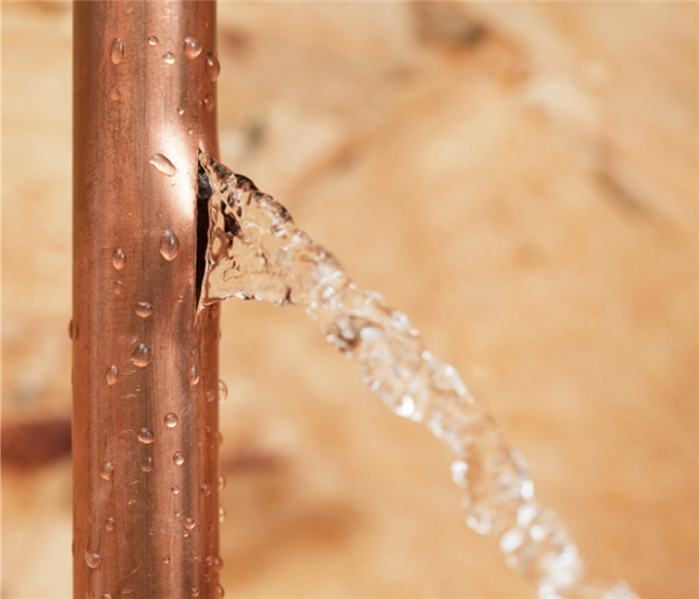 Where is your main water shut off valve?
Where is your main water shut off valve?
During the months of January and February we are struck with low temperatures and occasionally snow. When these winter weather events happen we usually do not realize the repercussions that come with it. For example, when the low temperatures kick in our pipes can break and cause flooding. A way to prevent this is making sure that your indoor temperature is set at a 68 degree minimum. Another way is to prevent cold breeze from entering is by sealing areas where cold weather intrusion is possible. If you happen to have water damage due to a broken pipe remember that your local SERVPRO of Wheaton/Kensington is here to help and make it “Like it never even happened.”
How to prevent water intrusion
11/11/2020 (Permalink)
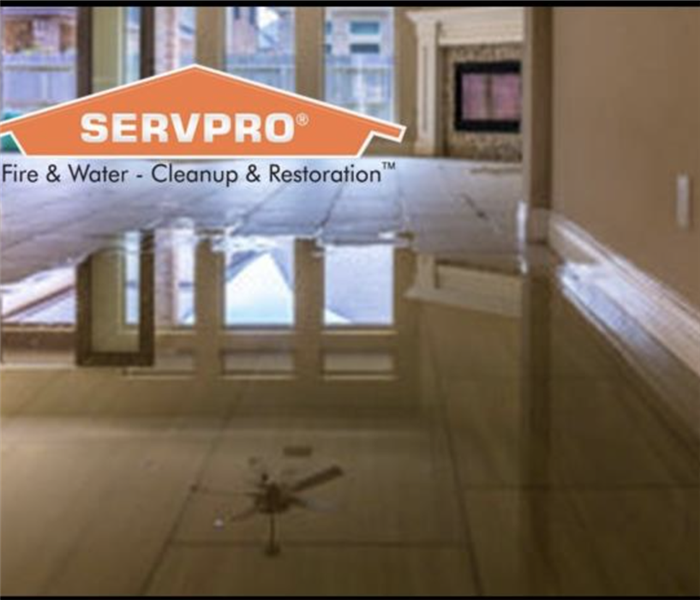 SERVPRO of Wheaton/Kensington, your water mitigation specialists
SERVPRO of Wheaton/Kensington, your water mitigation specialists
Did you know that most insurance providers do not cover water damage due to storm water intrusion unless you have flood insurance? Did you know that you have to live in a flood zone to be able to purchase flood insurance? Or did you know that water intrusion in considered a category 3 water loss? In all cases water intrusion is never a good thing, we know! Here are a few tips to prevent water intrusion in your basement or foundation.
- Create a flood barrier using sand bags to prevent water intrusion from basement doors.
- Improve outside drainage by unclogging your outdoor drains periodically.
- The overflow of water due to a clogged gutter can cause pressure to the foundation. Periodically cleaning your gutters can prevent damage to your foundation, which may cause water intrusion.
Remember, should you need assistance after water intrusion, we are always here to help. Your local SERVPRO of Wheaton/Kensington can make it “Like it never even happened.”
Protect your gutters from ice dams
2/17/2020 (Permalink)
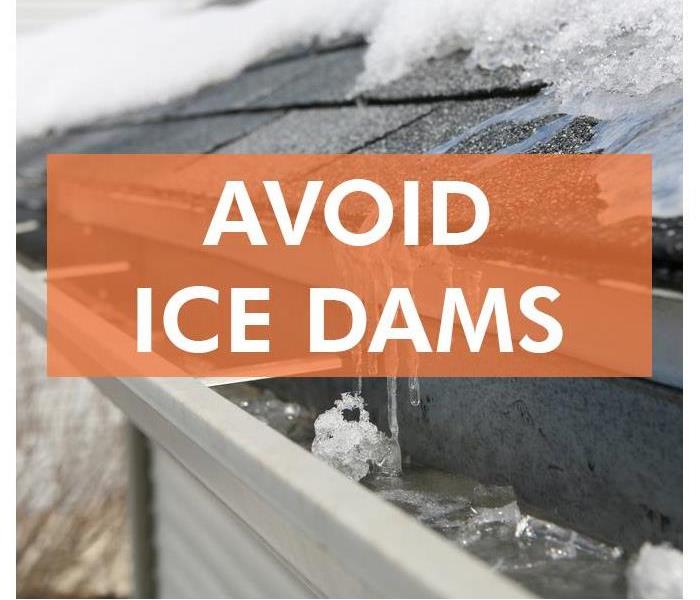 Ice dams can potentially cause water damage!
Ice dams can potentially cause water damage!
Icicles can be a sign of an ice dam on your gutters. You may ask yourself, how does that affect my home? Well, the dam build up on a roof can cause water to pool behind it and leak into your home. Also, melted water from the warm roof can back up behind it, flows under the shingles, and into the house. Below are a few tips to help prevent an ice dam in your gutters during the winter weather ahead.
Prevention tips
-Add insulation in your attic
-Remove attic heat sources
-Insulate attic access door
-Check the exhausts
-Check flashing around chimney
Keep in mind that your SERVPRO of Wheaton/Kensington is always here to help, and make it “Like it never even happened."
Categories of Water Contamination
1/7/2019 (Permalink)
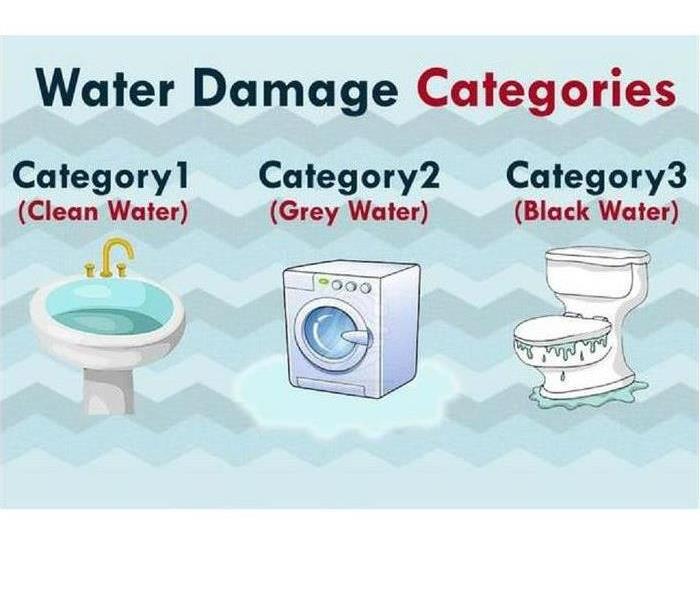 All water losses are different!
All water losses are different!
Here at SERVPRO of Wheaton/Kensington safety is our first priority. Knowing how to react when you experience a water loss is vital to you and your families’ health. All water poses potential health problems. It is the single leading cause of disease in the world. Understanding the different types of water contamination levels and their health risks can make a big difference in restoration process as well as minimize your chances in becoming sick. This information will help you determine if you need to evacuate the home or not. Below you will find a description of the different types of water contamination categories.
Category 1 – Clean Water: This water originates from a sanitary water source that does not pose substantial harm to humans. This may include broken water lines, tub or sink overflows with no contaminants, appliance malfunctions involving water supply lines, melting ice or snow, falling rain water, broken toilet tanks and toilet bowls that do not contain contaminants or additives.
Category 2 – Gray Water: This water contains a significant level of contamination and has the potential to cause discomfort or sickness if consumed by or exposed to humans. Examples of this include discharge from dish washers or washing machine overflows, toilet overflows, toilet overflow with urine, but not feces, and other sources where water has been contaminated.
Category 3 – Black Water: This water is grossly contaminated and may contain pathogenic, toxigenic or other harmful agents. Elderly, children under the age of 2, and people with respiratory issues should not occupy the facility until the building safe. Examples of Category 3 water are all forms of flooding due to sewage, flooding due to sea water or rain fall (rain, natural disaster), and colored water.
Keep in mind that every water loss is different, and determining the type of water category you have is the first step towards figuring out what the next step is. Once we establish the water category we put together our plan of action.
The information above was provided by The Institute of Inspection Cleaning and Restoration Certification (IICRC). We hope we’ve provided a better insight on the different water types. Remember that your SERVPRO of Wheaton/Kensington is always here to help, and make it “Like it never even happened.”
Faster to your Kensington/Wheaton water loss
6/8/2018 (Permalink)
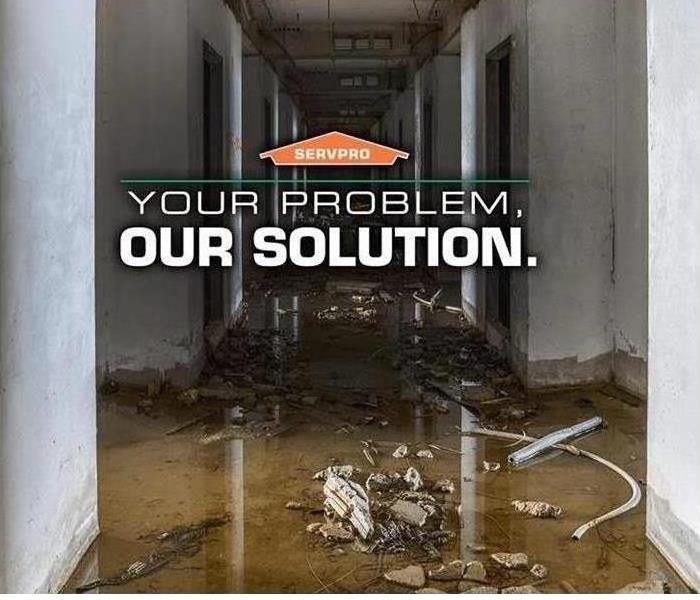 Let the professionals handle it!
Let the professionals handle it!
Along with a water loss comes a flood of emotions. You may be confused as to what to do next, or who to call. Here are a few tips on what your next steps should be, and whose information you should have handy just in case you have this unfortunate event happen to you.
First steps to follow for a water loss for clean water.
- Shut off the source of water if possible.
- Turn off circuit breakers for wet areas of the building, when access to the power distribution is safe from electrical shock.
- Remove excess water by mopping and blotting.
- Remove and prop up wet upholstery cushions for even drying.
- Place aluminum foil or wood blocks under furniture legs.
- Hang furs and leather goods separately at room temperature.
- Do not use a regular vacuum to remove water.
- Remove oriental or other colored rugs/books/magazines from wet carpeting.
Whose information should you have handy?
- We recommend you have an Emergency Ready Plan in place with your local SERVPRO location. This will facilitate the process for both you and your local SERVPRO. In the ERP form we have most of the essential information needed to begin the mitigation process for your home or business.
- Your Insurance Adjuster should be notified immediately after or during your loss.
- Your Plumber should be notified if the loss occurred due to plumbing/pipe issues. If the loss occurred due to those issues they can repair the cause of the of the water loss.
Remember that when a water loss occurs you are in a sensitive time frame to be able to recuperate your personal property and prevent further damage such as mold etc... Have this important information ready just in case.Also keep in mind that our goal is to make it "Like it never even happened."
Your SERVPRO of Wheaton/Kensington is always here to help!
Bathtub and Dishwasher Overflow
10/30/2017 (Permalink)
 Bathtub
Bathtub
Bathtub overflow: It’s important to make sure that fittings, seals, pipes, etc. are inspected thoroughly to prevent issues such as water damage.
The bathtub overflow drain can be the cause of a leak, even though it is not the first place you'd usually suspect. A water stain in the ceiling below a bathroom is often the first sign of a problem with a tub overflow drain.
Dishwasher Overflow: Is this something you've experienced before? "Why is my dishwasher leaking, where is it coming from?" There are many questionable factors for why a dishwasher is leaking
In these cases, make sure to contact a licensed and trained professional, like SERVPRO, to fix the issue. Our technicians source out the problem and fix the surrounding areas affected by water damage. It's not a fun experience dealing with any type of unexpected home repair, or disaster. However, SERVPRO helps alleviate your stress and turn your home back to a comfortable and functional space. While catching the problem early, it saves time and money.





 24/7 Emergency Service
24/7 Emergency Service











